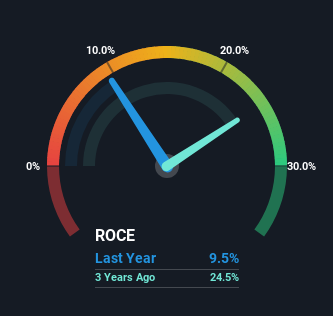Some Investors May Be Worried About E. Pairis' (ATH:PAIR) Returns On Capital
If we want to find a potential multi-bagger, often there are underlying trends that can provide clues. Typically, we'll want to notice a trend of growing return on capital employed (ROCE) and alongside that, an expanding base of capital employed. Ultimately, this demonstrates that it's a business that is reinvesting profits at increasing rates of return. Although, when we looked at E. Pairis (ATH:PAIR), it didn't seem to tick all of these boxes.
Understanding Return On Capital Employed (ROCE)
If you haven't worked with ROCE before, it measures the 'return' (pre-tax profit) a company generates from capital employed in its business. Analysts use this formula to calculate it for E. Pairis:
Return on Capital Employed = Earnings Before Interest and Tax (EBIT) ÷ (Total Assets - Current Liabilities)
0.095 = €1.0m ÷ (€20m - €9.7m) (Based on the trailing twelve months to June 2022).
Therefore, E. Pairis has an ROCE of 9.5%. In absolute terms, that's a low return and it also under-performs the Packaging industry average of 12%.
View our latest analysis for E. Pairis

While the past is not representative of the future, it can be helpful to know how a company has performed historically, which is why we have this chart above. If you're interested in investigating E. Pairis' past further, check out this free graph of past earnings, revenue and cash flow.
So How Is E. Pairis' ROCE Trending?
On the surface, the trend of ROCE at E. Pairis doesn't inspire confidence. Around five years ago the returns on capital were 17%, but since then they've fallen to 9.5%. However, given capital employed and revenue have both increased it appears that the business is currently pursuing growth, at the consequence of short term returns. If these investments prove successful, this can bode very well for long term stock performance.
On a side note, E. Pairis has done well to pay down its current liabilities to 48% of total assets. That could partly explain why the ROCE has dropped. Effectively this means their suppliers or short-term creditors are funding less of the business, which reduces some elements of risk. Since the business is basically funding more of its operations with it's own money, you could argue this has made the business less efficient at generating ROCE. Either way, they're still at a pretty high level, so we'd like to see them fall further if possible.
In Conclusion...
In summary, despite lower returns in the short term, we're encouraged to see that E. Pairis is reinvesting for growth and has higher sales as a result. And long term investors must be optimistic going forward because the stock has returned a huge 356% to shareholders in the last five years. So while the underlying trends could already be accounted for by investors, we still think this stock is worth looking into further.
E. Pairis does have some risks, we noticed 4 warning signs (and 2 which are potentially serious) we think you should know about.
While E. Pairis may not currently earn the highest returns, we've compiled a list of companies that currently earn more than 25% return on equity. Check out this free list here.
Valuation is complex, but we're here to simplify it.
Discover if E. Pairis might be undervalued or overvalued with our detailed analysis, featuring fair value estimates, potential risks, dividends, insider trades, and its financial condition.
Access Free AnalysisHave feedback on this article? Concerned about the content? Get in touch with us directly. Alternatively, email editorial-team (at) simplywallst.com.
This article by Simply Wall St is general in nature. We provide commentary based on historical data and analyst forecasts only using an unbiased methodology and our articles are not intended to be financial advice. It does not constitute a recommendation to buy or sell any stock, and does not take account of your objectives, or your financial situation. We aim to bring you long-term focused analysis driven by fundamental data. Note that our analysis may not factor in the latest price-sensitive company announcements or qualitative material. Simply Wall St has no position in any stocks mentioned.
About ATSE:PAIR
E. Pairis
Produces and sells plastic products made of polyethylene, polypropylene, and terepthalic polyethylene in Greece.
Solid track record with mediocre balance sheet.
Market Insights
Community Narratives



